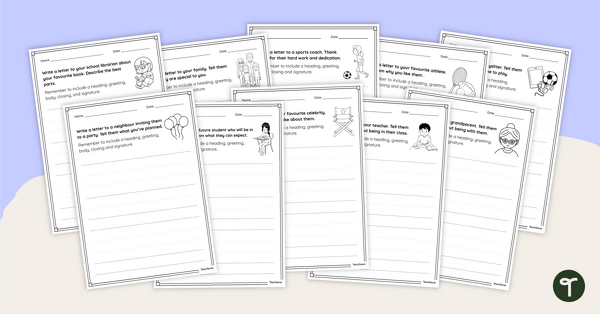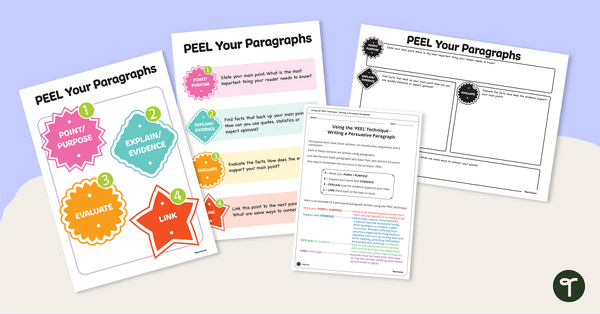Year 3
The English curriculum is built around the three interrelated strands of language, literature and literacy. Teaching and learning programs should balance and integrate all three strands. Together, the strands focus on developing students' knowledge, understanding and skills in listening, reading, viewing, speaking, writing and creating. Learning in English builds on concepts, skills and processes developed in earlier years, and teachers will revisit and strengthen these as needed.
In Years 3 and 4, students experience learning in familiar contexts and a range of contexts that relate to study in other areas of the curriculum. They interact with peers and teachers from other classes and schools in a range of face-to-face and online/virtual environments.
Students engage with a variety of texts for enjoyment. They listen to, read, view and interpret spoken, written and multimodal texts in which the primary purpose is aesthetic, as well as texts designed to inform and persuade. These encompass traditional oral texts including Aboriginal stories, picture books, various types of print and digital texts, simple chapter books, rhyming verse, poetry, non-fiction, film, multimodal texts, dramatic performances and texts used by students as models for constructing their own work.
The range of literary texts for Foundation to Year 10 comprises Australian literature, including the oral narrative traditions of Aboriginal and Torres Strait Islander Peoples, as well as the contemporary literature of these two cultural groups, and classic and contemporary world literature, including texts from and about Asia.
Literary texts that support and extend students in Years 3 and 4 as independent readers describe complex sequences of events that extend over several pages and involve unusual happenings within a framework of familiar experiences. Informative texts include content of increasing complexity and technicality about topics of interest and topics being studied in other areas of the curriculum. These texts use complex language features, including varied sentence structures, some unfamiliar vocabulary, a significant number of high-frequency sight words and words that need to be decoded phonically, and a variety of punctuation conventions, as well as illustrations and diagrams that support and extend the printed text.
Students create a range of imaginative, informative and persuasive types of texts including narratives, procedures, performances, reports, reviews, poetry and expositions.
(source: www.australiancurriculum.edu.au)
Achievement Standard
Receptive modes (listening, reading and viewing)
By the end of Year 3, students understand how content can be organised using different text structures depending on the purpose of the text. They understand how language features, images and vocabulary choices are used for different effects.
They read texts that contain varied sentence structures, a range of punctuation conventions, and images that provide extra information. They use phonics and word knowledge to fluently read more complex words. They identify literal and implied meaning connecting ideas in different parts of a text. They select information, ideas and events in texts that relate to their own lives and to other texts. They listen to others' views and respond appropriately using interaction skills.
Productive modes (speaking, writing and creating)
Students understand how language features are used to link and sequence ideas. They understand how language can be used to express feelings and opinions on topics. Their texts include writing and images to express and develop, in some detail, experiences, events, information, ideas and characters.
Students create a range of texts for familiar and unfamiliar audiences. They contribute actively to class and group discussions, asking questions, providing useful feedback and making presentations. They demonstrate understanding of grammar and choose vocabulary and punctuation appropriate to the purpose and context of their writing. They use knowledge of letter-sound relationships including consonant and vowel clusters and high-frequency words to spell words accurately. They re-read and edit their writing, checking their work for appropriate vocabulary, structure and meaning. They write using joined letters that are accurately formed and consistent in size.
(source: www.australiancurriculum.edu.au)
- Plus Plan

Writing Editing Checklist
Get your students using this editing checklist so that no mistake gets left behind!
- Plus Plan

Persuasive Letter Example Pack
Download this persuasive letter example set featuring five model letters with labelled and unlabelled versions, perfect for teaching students the structure of a persuasive letter.
- Plus Plan

Singular and Plural Subject Verb Agreement – Interactive Activity
Teach singular and plural subject-verb agreement with this interactive drag-and-drop resource, designed to help students master correct verb usage in a fun and engaging way.
- Free Plan

Word Detective Worksheet - Context Clues
Assign our Word Detective Worksheet to give your students extra practice in using context clues to find the meaning of unfamiliar words.
- Plus Plan

Letter Writing Prompts Worksheets
Encourage young writers with these letter writing prompts, designed to help students master letter structure while engaging with fun, relatable topics.
- Free Plan

Making Predictions from Sentences Worksheets
Practise making predictions with sentences using this set of making predictions worksheets.
- Plus Plan

Reciprocal Teaching Role Cards
Assign reciprocal style teaching roles to your students during small-group reading sessions with this set of 4 reciprocal teaching role cards.
- Plus Plan

Editing and Revising Checklist Pack
Download this editing and revising checklist pack to support your students when revising and editing their written work.
- Free Plan

Informative Text Writing Task – Why Do Volcanoes Erupt?
Research and write about how volcanoes erupt with a scaffolded informational writing task.
- Plus Plan

Genre of the Month - Writing Prompt Grids (Upper)
Introduce your students to a variety of writing genres with our printable genre-specific writing prompt grids.
- Plus Plan

Koala Information Report – Writing Project
Get your students writing a koala information report using this age-appropriate fact file and writing scaffold.
- Plus Plan

Information Report Checklists
Use these information report checklists when teaching your students how to edit their informative texts.
- Plus Plan

Informative Writing Posters
Display this set of 5 information report posters in your classroom during your informative writing unit.
- Free Plan

Present and Past Tense Regular Verbs Matchup Cards
Learn about simple present tense and simple past tense of regular verbs with this match up activity.
- Plus Plan

Contractions Worksheet Pack
Help students learn more about contractions with this contraction worksheet pack.
- Plus Plan

How to Make a Pizza Interactive Activity
Use this “How to Make a Pizza” procedural writing interactive activity to model the purpose, structural elements and language features of procedure texts.
- Plus Plan

Procedural Writing Posters
Display this set of 5 procedural writing posters in your classroom during your procedural writing unit.
- Plus Plan

Dolch Sight Words List – Complete Set
Practise word recognition with our set of 8 Dolch Sight Word Lists.
- Plus Plan

Persuasive Devices Crossword
Familiarise your students with the most common persuasive devices with an engaging crossword puzzle.
- Plus Plan

Persuasive Devices Sorting Activity
Explore persuasive devices with your students using this set of sorting cards.
- Plus Plan

For and Against Worksheets
Explore 'for' and 'against' arguments for five different topics with this set of 'for' and 'against' sorting activities.
- Free Plan

PEEL Paragraph Structure Poster and Worksheets
Explore the acronym PEEL to help with paragraph technique during persuasive writing lessons.
- Plus Plan

Year 3 Magazine - What's Buzzing? (Issue 1)
A beautifully designed, 24-page reading magazine specifically designed for Year 3 students.
- Free Plan

Finding the Main Idea - Graphic Organiser Templates
A worksheet to use when teaching students how to find the main idea of a text.
- Plus Plan

Common Spelling Rules PowerPoint
Boost your students' spelling skills with an instructional slide deck teaching the different spelling rules.
- Plus Plan

True or False? Active Listening Exercises
Improve listening skills in the classroom with an engaging True or False Active Listening Activity.
- Plus Plan

Epic Editing Workbook – Year 3 and Year 4
Use these paragraph editing worksheets to get your students practising and refining their proofreading skills.
- Plus Plan

Their, There, They're Poster
Teach students to differentiate between their, there and they're with this classroom poster.
- Plus Plan

Recount Writing Checklist Pack
Use this recount writing checklist pack when teaching your students how to edit their writing.
- Plus Plan

Everyday Grammar Punctuation Warm Ups - Middle Years Interactive PowerPoint
An engaging 44 slide interactive PowerPoint to use in the middle years classroom when learning about grammar and punctuation.
- Plus Plan

Writing Procedural Texts Teaching Slides
Use this procedural writing PowerPoint to teach your students about the purpose, structural elements and language features of procedure texts.
- Plus Plan

Comprehension Task Cards - Distinguishing Between Fact and Opinion
A set of comprehension task cards to help students distinguish between fact and opinion when reading.